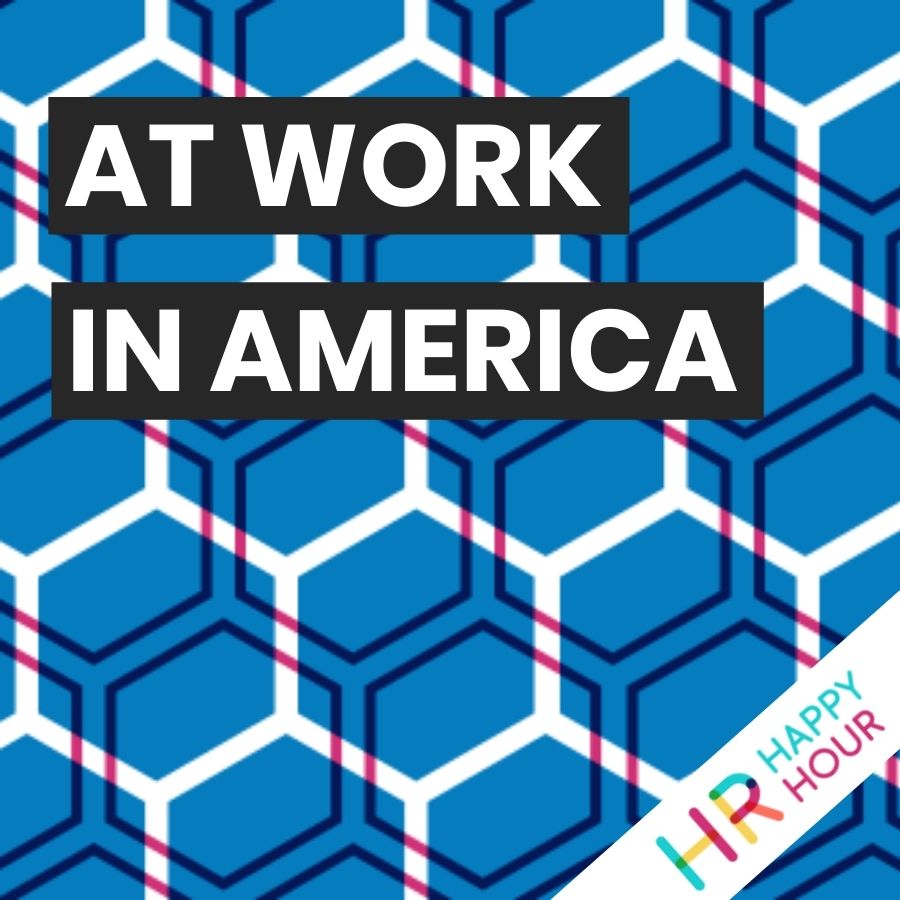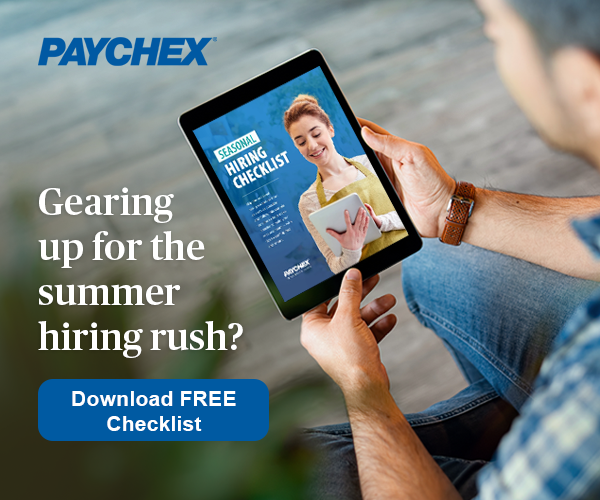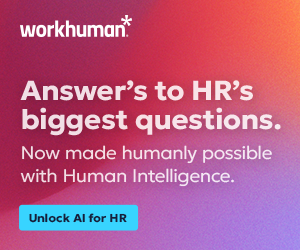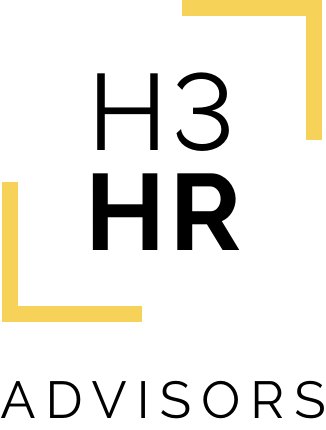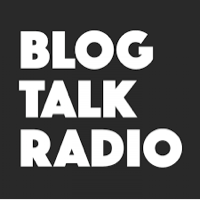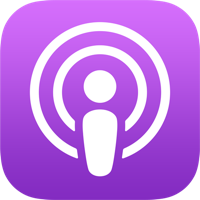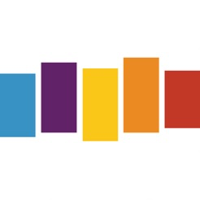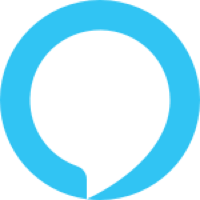Benefits of Building Accessible Workspaces for All – featuring Google
Hosted by

Steve Boese
Co-Founder and Chief Data Officer of H3 HR Advisors and Program Chair, HR Technology Conference

Trish Steed
Co- Founder and Chief Strategy Officer, H3 HR Advisors
About this episode
Benefits of Building Accessible Workspaces for All – featuring Google
Hosts: Steve Boese, Trish Steed
Guest: Tracy Needles, Global Lead for Accessibility & Inclusion, Google
This episode of At Work in America is sponsored by Paychex, one of the leading providers of HR, payroll, retirement, and insurance solutions for businesses of all sizes. Even the most seasoned professional can easily be overwhelmed by the critical tasks that need to be done during year-end. Download the Paychex Year-End Checklist to get organized. In it you’ll find timely tips, important deadlines, and advice backed by decades of experience to help navigate this time of year, so you don’t lose momentum as you transition to 2023. Visit paychex.com/awia to download your copy, today.
This week, we met with Tracy Needles from Google, to talk about the importance of building accessible workspaces within your organization.
– Trends in developing an inclusive workspace design
– Tips to incorporate more universal design into your space
– Thoughtful vs trendy design
– Research developments on controlled sensory environments
Learn more here
Thank you for joining the show today! Remember to subscribe wherever you get your podcasts!
Transcript follows:
Announcer 0:25
Welcome to At Work in America sponsored by Paychex. We welcome a wide and exceptionally impressive array of guests, business leaders, HR leaders, academics, practitioners, consultants and authors to talk about the most timely, relevant and challenging issues that are influencing the workplace today. At Work in America digs in behind the headlines and trends to the stories of real people making a difference in the world of work. And now here are your hosts, Steve Boese and Trish Steed.
Steve 0:59
Welcome to the At Work in America show! We have a great show for you today, we’re super excited to be talking about accessibility, and inclusion, but with a different spin on those topics than anything we’ve talked about before in the show. So first off, Trish, how are you today? Great to see you.
Trish 1:14
I’m good. How are you? I’m excited for the show today.
Steve 1:18
I am well and I am too Trish, we’ve covered disability, workplace inclusion, disability issues, accessibility to opportunity quite a bit on the show over the last couple of years. We’ve never talked about the importance of the focus on building accessible spaces and workplaces. I’m talking about physical spaces, right. And it’s a fascinating topic. I can’t wait to dive into it, we have a wonderful guest probably the best person we could find to talk about this. We’ll welcome her in a second Trish. I do want to thank our friends at Paychex. Of course, this episode of At Work in America is sponsored by Paychex, one of the leading providers of HR, payroll, retirement and insurance solutions for businesses of all sizes. Even the most seasoned professionals can be easily overwhelmed by the critical tasks that need to be done during your end. But you can download Paychex year end checklist to get yourself organized. And you’ll find timely tips, important deadlines and advice backed by decades of experience to help navigate this time of year, so you don’t lose momentum. As you transition to 2023. Trish, you can go to paychex.com/awia that’s paychex.com/awia to download your copy today. Trish, they do this every year. And their year end checklist is fantastic. And it’s a great asset and resource. It’s free to everyone you don’t have to be a Paychex client to get it.
Trish 2:38
I’m glad you mentioned it’s free because it’s so true this time of year when I was still a CHRO, I was absolutely trying to find any resource I could in terms of my year end planning. So please take advantage of this nice free resource they provide and it’s full of great information.
Steve 2:57
Yeah, and I look forward to our show we’ll be doing our annual show we’re doing with Tom Hammond from Paychex as well to talk about year end and helping firms get ready for next year. All right, Trish, without further ado, I don’t want to make her wait any longer. Our guest today is Tracy Needles. She is the real estate and workplace services global lead for accessibility and inclusion at Google and we’re going to be talking about the importance of building accessible spaces for all. In her role Tracy’s mission is to create services and spaces in the workplace that allow Googlers regardless of their identity to feel productive, safe and independent when they come to work every day. Tracy’s passion for inclusive design has been influencing her work since she began at Google back in 2011. Tracy’s interest in Universal Design began during her time at Cornell University, where she earned her undergraduate and master’s degrees. While there she experienced a repetitive stress injury. That’s thanks, exposing her to the impact design can have in our experiences every day. Tracy currently resides in the Upper West Side of New York City with her husband, her toddler and their dog. She’s a lot going on. Tracy, how are you? Welcome to the At Work in America show. Good to see you.
Tracy Needles 4:08
I’m good. Good to see you too excited to be here.
Steve 4:11
I mean, it’s great to have you and it’s great that you survived several years in upstate New York. I’m familiar with the New York area. By several times during your stint up there.
Tracy Needles 4:26
No, it was definitely cold. But you know, dressed for it and enjoys my time up there for sure.
Steve 4:32
Awesome. Well, it’s great to have you. We talked a little bit before the show about Tricia as well about how we’ve done a number of shows in the last year or two around accessibility and inclusion. But really more about access to opportunity. Right if I had to say one theme we’ve covered over and over again, is sort of access to jobs and access to even just interviews right for folks who may be underrepresented or for better regions have challenges in traditional workplaces. And I think those are great topics. And they deserve attention. And I’m glad we spent a lot of time on them. But this topic is a little bit different about building actual accessible spaces for all. And I’d love for you to tell us just a little bit about, I don’t know what drew you into that we talked, we have this story about the repetitive injury you suffered back in college. But what led you to think, Hey, this is an important thing. And organizations such as Google really need to consider the spaces that we provide for folks to to sort of do their best at work.
Tracy Needles 5:32
Yeah, definitely. I think if I think back to what you mentioned, at the beginning, when I was in college, I hurt my thumb, playing soccer and ended up wearing a splint for a year to try and fix it. And I was living in a pretty old sorority house at the time, and I realized, you know, you can do something like wear a splint. And all of a sudden, I couldn’t open the door, I couldn’t turn on the shower. And I happen to be taking a class around diversity by design, which was all about how do you how do different types of people experience space? And how does that influence your, just your experience in the world, and it really hit me that, you know, you can have a power in creating spaces that make people feel a certain way. And there’s something around the concept of disability, I’m not sure if you’ve covered it before around the different models of disability. So if you have the medical model, it says, you know, I have a medical problem, the problems on me to fix it, I need to adapt to the way the world works. And that’s true in hiring, and also in physical design. But we really think like to think of it through the social model. So we have the opportunity to remove barriers, and then it doesn’t so much rely on you to address your disability, you don’t need an accommodation, because we’ve already pre thought of it. And I think it’s a really interesting point that you bring up, which is there is a lot of focus on getting people in the door. But where we see the real opportunity is how do we make those people want to stay and feel like they belong when they’re there? Because it’s one thing to hire someone and, you know, it’s great. It’s a great initiative.
Tracy Needles 7:08
And we actually partner a lot with our friends in the HR world to make sure we’re kind of in lockstep. So we know, you know, what, what efforts they’re making, and how can we kind of work with them. But I just saw a huge opportunity. When I started at Google, my career started in facilities management, so it was a lot around, what are the little things we can do that don’t cost money, because money is often the barrier to entry. So what are those things that can just make someone’s experience that much better, because it’s not always the big things, it’s not, you have to design this like wildly expensive space, it’s just, if you put yourself in the shoes of someone with a disability, it’s the experience you go through. And I always go back to I did it myself. And I sat in a wheelchair for a day and went to one of our kitchens and realize that it was something as small as where we put the paper towel dispenser. So I washed my hands, I could luckily reach the sink. But then all of a sudden, I realized, Okay, now to go dry my hands, I have to touch my wheels again, get dirty, and then go touch the head and move over here. And it’s that kind of through the lens of the experience of a disability or just different identities, you can start to build empathy and then build. It’s so multi layered. It’s anything from the layout of the space to like I just said where the hand dryer goes. That’s part of our opportunity in my team’s role, but also part of the challenges for sure.
Trish 8:37
Yeah, it’s interesting, because as you’re talking, I’m thinking back I did kind of mid career, I did some time working for St. Louis Children’s Hospital. And we did not have a specific team like you do where you’re sort of focused on that, but and we weren’t focused on it from an employee perspective. And I’m like kicking myself now like hearing this thing. And like, why didn’t we but we always focused on the children who had different physical, mental, other challenges. And like you’re saying, being done at the right level, if you’re in a wheelchair, where things are where their position, so we were doing that for our patients, but we weren’t doing it for the employees. And at that particular time, it was a team of people who worked in all the different departments of the hospital who sort of got together on the side, to innovate around how we approach that. I would love to hear about your team specifically and what like, what kind of people obviously you’re saying you started with a facilities sort of a, an angle, what is what is the makeup of your team? What type of background do they have? And and how do you all sort of approach that? Because I think there are probably a lot of organizations that were maybe kind of doing it like we were doing which was sort of piecemeal, a little bit. Love to hear what you’re actually doing there.
Tracy Needles 9:54
Yeah, I think it’s a great point. I think unfortunately, far too often. This work is a volunteer work like, as I mentioned, I started as a facilities manager, and I just did this as my, as they say, 20% project for the better part of 10 years, I’m super lucky that Google is a place where you’re able to kind of pitch ideas and evolve over time. And I was lucky enough, about two years ago now to have this role created as a dedicated focus for our real estate and workplace services team. So we got started off with just me, it’s we’re a team of three right now. And I think we’re moving slowly on purpose in terms of how we scale and how we approach the topic. And so right now, my team is made up of one person that’s focused on operations. And their background is actually in a facilities world like mine. And they, they apply a lens of, you know, cut, as I said, coming up with new guidance and coming up with new stuff is really important. And that’s what the other person on my team does. But how do we look at all the existing space, the millions of square feet that exist? And how do we enable our operations teams to make that space better, and then also just process driven approach to improve the the just the experience, because someone’s experience in our space varies from, you know, it could be the transportation into the office, it can be the receptionist and how they greet you. And so it’s again, so multi layered. So that’s that one person’s job is really looking at that. And then also trying to figure out, what’s the data look like? We don’t have data right now. And we, we haven’t built it into our process over the past X number of years. And so how do we go back and really just manually understand, like, where are the gaps that we need to fill in the future? Like, where are the auto openers? Where are we missing that and those sorts of things. It’s very basic, but it’s very important. And then the other person on my team, he’s new to Google, and he is fully focused on that. He’s looking at how do we make sure that new designs, a know how to use the information we already have? So the guidance, we have a project guide for projects and designs? But then also, how are we continuing to keep up with the industry and think about new topics? I know, you had mentioned before, like neurodiversity, for example, like, that is a topic that has a lot of articles written about it. There’s a lot of stuff in the media, but there’s not a lot of data. There’s not a lot of like real research, or when it comes to neurodiversity in the built environment. And what does that really mean? And so his focus is kind of twofold. How do we get people to understand the guidance that exists? And how do we come up with innovation and kind of keep pushing ourselves to be at the forefront of this and his background, is actually in children’s medical field. So helping helping to co design alongside and make these maker spaces with kids in a pediatric setting. So it’s very similar, very empathetic, very user first approach. And I think that will serve him really well as we continue to expand.
Steve 12:59
Thank you for sort of explaining how it works there and what you’re hoping to accomplish and what you’re working on. You mentioned guidance a couple of times, I look for to talk about that for a second. Because when you were telling your example of the paper towel dispenser in the one office that you visited, and that it was not reachable for someone, say in a wheelchair, I thought, wow, that’s really that’s a good point. That’s really thoughtful. And I also thought that is a small, small detail, right of setting up a break room. Maybe in this case, it might have been the easy to miss. Certainly right. And then it made me think of Wow, there must be 1000 other of that example, especially in a big facility that might house at any one time a couple of 1000 employees say right at a large organization. So is that the type of thing you try to incorporate into your guidance that you kind of roll out throughout the organization? Is it that level of detail? Or is it a bit more generalized to say, hey, you need to think about these things before you start, you know, nailing things to walls, etc, etc.
Tracy Needles 14:05
Yeah, I think it’s certainly been an evolution over time. And we’re always learning. So we’re always also in this kind of like, release something learn from it improve. And I think one of the things we’ve learned over time is, we can never give a checklist like you’re there’s so many widgets and things that people are putting, they’re coming up with new technology and different things every day. So like, having a checklist is not really the solution. And it also, in some ways limits us to say, you know, Oh, you did these five things, you’re good to go. Like, we don’t want that to become a crutch. And so the way we’ve kind of pivoted and taken the approach is trying to develop more of an inclusive mindset across all of our teams. So how do we get everyone to start asking the question of, you know, a first understanding what it means to have a disability and what that lived experience looks like. And then serving them with the tools to ask the questions throughout the process. So, in a lot of ways, sometimes it’s the project team who’s designing the physical space. And then it’s the facilities team is coming in and hanging up, for example, to go back to that paper towel dispenser. And so how are we giving them all the resources to understand, here’s the reach range for someone in a wheelchair, here’s how high they can reach. Like, based on data, here’s the depth. So we don’t have to say every widget has to be at this height or that height. Because also, I think it’s really important and helps me in my role coming from my background is just knowing that in the reality, it’s not a perfect world, like you’re going to be dealing with sometimes old buildings or historic buildings. And you can’t say that the door badge reader always has to be on the right side, and at this height like that, that’s going to cause friction. And so how do we get people to more focus on the experience and understanding different experiences, especially if the 10 people sitting around the design table are of the majority of people and you don’t have a lot of diverse opinions, you want them to be able to also, like have the ability to ask those questions and feel comfortable. So a lot of our work over the past year has been foundation building, education building. And then here’s, we still do provide guidance, obviously, but it’s very much like, here’s the core things that no matter what you’re doing, here’s the dimensions you need to meet. Here’s the like, it’s almost like the reverse. It’s the things not to mess up, like here are the things that you really don’t want you to mess up and stay away from these kinds of pitfalls that we see over and over again. And then here’s how we can help guide you along the way.
Trish 16:34
Yeah, thank you for sharing that. One thing I was thinking of, as you’re talking about kind of thinking about all of these changes, and I love the idea that you don’t have to just be so prescriptive, like, oh, this reader needs to be on the certain side, right? It sounds like you’re, you’re given sort of that leeway within the various buildings that you’re dealing with to make those decisions or recommendations. Are there people within the different, you know, Google facilities who maybe are neurodiverse, or atypical thinkers, or maybe they have physical disabilities who also give input on some of the directions that this, you know, three person design team is kind of thinking or right now, is that still very much? I mean, I know it’s fairly new in terms of a dedicated role. But how are you handling that in terms of kind of getting these ideas to begin with?
Tracy Needles 17:27
Yeah, it’s a great question. I think there’s a saying in the disability community, and I know in other communities, nothing about us without us. And that’s one of the core pillars of how we approach our work. We have to strike a balance, we obviously can’t, like, the people we’re working with might be engineers, and might have ideas about how to build a building, but they don’t know how to build a building. So we’re trying to they’re called employee resource groups at Google. And we’re trying, we’re partnering with our people operations teams to understand how do we systematically and scale our approach to make sure they feel like they can approach us and give us their feedback. And then we’re taking that feedback and saying, Okay, we have to balance what is ideal state for someone, and what reality can provide us in our buildings. And so that’s kind of that mechanism that we play. And that’s a core part of our team is helping to distill the knowledge, both from the lived experience, and we’re also tapping into just industry experts. Like, I think one of the parts of my team that I was super excited to build is, if you go out into the research around design for disability, there’s often very narrow focus. And so you have, for instance, like Gallaudet University designed for people who are deaf for you have Lighthouse for the Blind design for people who are blind. But in a workplace like Google, you’re, you’re having an intermingling of all these different typologies of people and how they think and how they experience the world. And so how do we, as a team, be better at in taking all of that, and then being able to just sometimes they’re going to disagree, like something that’s good for one person is not going to be good for another? And how do we provide the best use case, and then allow for people to select and I think one of the biggest things, especially when you talk about neurodiversity, is we need to just provide flexibility, there’s not going to be neurodiverse, friendly, perfect space, because people are on the spectrum. So how do we make sure we’re providing different experiences for you to opt into? So you know, and how do we surface that? And how do we make sure someone knows that here’s a quiet place where you can go if you want quiet, here’s a noisy place if you want noise. And so that’s kind of our approach is we listen, we intake we also tap into the industry. We’re constantly trying to push ourselves to continue to evolve there.
Trish 19:47
Yeah, it sounds like you’re you’re taking all of those things into consideration, which I think I loved your point earlier on that you don’t it’s not necessarily an expensive endeavor. For each of these things that you might implement. Right? It could be something As simple as, you know, certain colors that are used in different parts of the building or, you know, again, it’s sort of thinking back to what we were doing for kids who had these issues. But it was like, you know, it might be a hand railing that’s sort of wavy, so that someone who thinks differently might find that more appealing, right? Or comfortable or using QR codes, maybe to help people who need to move around a facility where they feel uncomfortable asking someone face to face, for example. So I think it’s, it’s nice that you’re kind of open to those creative ways to do it. And that it doesn’t necessarily cost a lot. And secondarily, it doesn’t necessarily mean that they have to, sort of self identify I liked early on when you talked about it being just sort of something you’re proactively doing. So because I think, Steven, a lot of those shows we’ve done where we’re talking more about opportunities. There is such a resistance for people to self identify whether it’s with a physical or an emotional or mental sort of difference, they might think that that’s going to hurt their career. Right. So I love this thing for sure. Yeah. Right. So I don’t know, I just I commend you on that. Because I think that’s, that’s a different way of approaching the problem, too. It’s not kind of I mean, there aren’t any right answers at this point. Like you’re saying, there aren’t a lot of studies just yet. But I do think that’s a much better way to sort of proactively do it than to reactively do it when, like many of us in HR, we’ve got so many things on a plate, someone comes to you and says, Oh, I have this need. Yeah, can you? Can you make this accommodation? Right? It’s sort of like then you make all these little tiny accommodations, but it doesn’t really flow.
Tracy Needles 21:43
In the general space. Yeah, we’re definitely trying to approach both ends, because we recognize that, you know, universal design, and the way we’re approaching just overall, it’s like, how can you design a space that meets as many people as possible while still recognizing that there’s going to be, you know, accommodations are there for a reason. And so we’re again, not gonna be able to make everything perfect for everyone. But if we can at least, provide optionality? And I think a big part of what we’re looking at is also how do we raise awareness of what we’re doing? So that to your point, you don’t have to ask and then someone has to tell you where the solution is, like, how do we make this information more readily available, but I just wanted to like, definitely reinforced the fact that it doesn’t have to cost more, but it is really important to get into as Steve, you were saying in the beginning, like what can other people do? I think the biggest thing someone can do is to think about it early. Because the earlier you get it into the mindset of whether you’re designing or operating the space, the a less expensive it’s going to be and be the easier it’s going to be to adjust. So I always like to harp on, like circulation is huge for a multitude of different disabilities and neurodiverse populations. And, for example, sometimes designers will want to, you know, create a meandering path or create surprise and delight where the pathway goes side to side. And that’s interesting, sure, but at the same time reinforcing the fact that, you know, straight pathways and member memorizable spaces, places you can, you know, commit to memory are really important for people who have different learning types, but also people with disabilities. So it helps someone who’s visually impaired, it helps someone who might be neurodiverse, and just needs to understand the routine. And so if we can reinforce that, I think that is one of the ones that I’ve continued to point out to our teams to say, you know, if you get this wrong, you can’t go back and like, knock down the whole building and redo the layout of the floor, you can repaint the wall, if we happen to make mistake there.
Steve 23:44
Good point Tracy, right, moving that paper towel dispensers of 10 minute job probably right, right. But changing the architecture of the flow, the layout from one side of the building to the other, it’s maybe not doable job, quite frankly. Structure, right. It’s over with. I had one other questions sort of me, I was just thinking about it a little bit of an aside, I think relevant, not just for maybe what you and the team do, I gewann continue to do. But for all folks who are listening to this, we’re kind of in that middle of sort of people coming back to physical workplaces who perhaps hadn’t been in them very much, or at all for a couple of years. Now. I wonder if and I think Google is one of these companies that’s probably adopted some kind of a hybrid scheme, and people are coming in more, perhaps now than they had been. And you know, Google is very famous for their culture, their collaborative culture and their fantastic workspaces that people wanted to go to. Right. Has Has the work from home era. And now the transition back made your and the team’s role may be a little more challenging. And I’m saying that because I’m thinking if I was working from home for two or years or three, two and a half years, if I could I was likely to design my I work from home set up exactly how I wanted it to support my my learning style any disabilities that I might have my preference for the way I’d like to work on and on and on. And now I’ve been coming back into a workplace that I don’t have a lot of control over. Right, the design, is that something that’s come up? Do you think about that? Has that raised any challenges for you and the team there? And I’d love your thoughts on that.
Tracy Needles 25:24
Yeah, I mean, I think it’s certainly, what it is like that is the reality is that people had two ish years of fully work from home time around. I think for us, we see it as a bit of an opportunity in that I think, when people pivoted and work from home, they learned how to adapt, they identified things that made it more productive to be at home. And what we’re trying to do is identify what about the office space? Could we learn from that, and then improve that office space, I think, for one for my team, there’s so much work to be done in just really up leveling inclusion. And we, we like to not look at the numbers and say, you know, there’s this percent of people with a disability in our office, because if one person is experiencing exclusion, that’s one too many. And so we’re trying to really focus on our offices should be a place where everyone feels like they can come back to work, you may still decide that at home is better for you. And that’s everyone’s prerogative. And that’s why there’s this hybrid moment happening, you know, globally. But I think we want it to be a place where you shouldn’t feel like the office is not right for you because of something we built wrong. And so I think it’s, it’s definitely opened an opportunity for us to say, you know, we’re going to continue to push this because we want you to come back. And what we don’t want to do is have segments of the population all of a sudden retreating to their home. And then you lose that culture in the office, and then all of a sudden that perpetuates more problems. So I think yeah, we definitely see it as learning and it’s, it’s continuing to evolve with just work in general. So we’re, we’re keeping our eye on it, for sure.
Trish 27:09
Are there any, I guess, innovations within the way you’re designing currently, that you could share that you were just like, wow, we thought that might be a little out there for what our employees were used to or expecting? That’s really maybe gone over? Well. And I guess the second part of the question is, for those who are listening, who might have made changes to their office space that didn’t go over? Well, like, how do you kind of deal with those moments, too?
Tracy Needles 27:41
Yeah, I mean, I think we definitely take a learning mindset of, you know, things are going to fail or not necessarily fail, but just not be as successful as we thought. I think in terms of things that, that we find that have been implemented that are more, as you said, like were more successful than we hoped or just successful in general. One is, it’s just the aspect of quiet spaces and providing, like I said, before, providing spaces where someone can feel comfortable, like retreating to and it doesn’t have to have a big sign on it or be an accommodation, I think it’s been a learning of these spaces are really important for large portions of the population. And you don’t have to identify as having a disability. And I think going back to the idea of returning to work, those also have come up is very important. Because you could do that when you’re in your house, you can, you know, step away from the computer, be by yourself, be quiet. And all of a sudden, people were reemerging into the social world in general, and a lot of people needed that sort of retreat space. And so I think that’s something that is kind of one of those ones where you it makes sense. And then we’re just happy that it’s been reinforcement, it continues to evolve and we’re continuing to figure out, you know, what, what are the spaces look like at scale? I think a lot of our just reinforces a lot of it is just basics. It’s things like, you know, circulation pathways being clearly identified by materiality. And so you know, if you have furniture in a hallway, it should be have a carpet around it so that someone can identify when that’s coming up and continuing to just reinforce these baseline like, design philosophies that don’t have to be fancy. I think one of the things we struggle with is people often ask, like, what’s the, the best project you’ve worked on? Or the you know, coolest thing and it’s good design and good, inclusive design really shouldn’t stand out. Like it should just blend in it should. It shouldn’t be this fancy, like one room. That is like got bubbles in it and all this stuff. It’s I think that’s one of the problems with a lot of the trendiness and inclusion right now, is that like, Okay, so we’re gonna spend all our time building this one room But realistically, it’s about the holistic approach to how you design and build a space. And if you’re doing it right, you just don’t have any issues or less issues, I should say. It’s not like going to necessarily win a design award all the time.
Steve 30:14
Yeah, in a weird way, that approach almost Tracy can end up being less inclusive, right, if you’ve built this fantastic room somewhere in the facility that folks really gravitate towards and accommodates them, if you will, to use the combination where and you didn’t really think about the whole rest of the space, including the parking and the transport to work in the break rooms and all the things you talked about. You’ve kind of just told those people. Well, we’ve created this space for you. You go go over there.
Steve 30:41
Yeah, exactly.
Steve 30:44
It could backfire. Yeah, absolutely. That’s fascinating. Yeah.
Trish 30:48
Well, I think too, I love what you said about the whole part about trends, because I had written that down what, what does good thoughtful design look like versus trendy design. And I think that’s it. I’ve I’ve worked in workplaces before, where an entire office was just completely redone by a design team. This is you know, 15 or so years ago, but it was like, it was all done so that everything in the office would be mobile, everything was on wheels, so we could wheel our wheel our desks there. And the whole idea was to bring teams together in different ways, which is really great concept. But in reality, it was a whole group of tax professionals, who definitely are introverts. And we’re not going to be mailing where, right. So it’s like, yeah, it’s like an uprising. So I love what you’re saying about like, the design actually, isn’t necessarily something you want to notice or stand out, it should just help the flow of the way that people work and that they are being inclusive through that flow versus, hey, this is a really cool new trend. And then you have everybody feeling uncomfortable, right? What you’re talking about is total exact opposite. It’s going to make hopefully, more if not everyone feel more comfortable. Right?
Tracy Needles 32:04
100% Yeah.
Steve 32:06
I’m just trying to let you go here in a minute. And thank you for spending so much time with us today. It’s been fascinating, but I just one thing I’m walking away with, and I think it’s a good takeaway. And hopefully for other folks who are listening to this is, I was just at, at a big big office building very professional place, huge campus building. Few weeks ago, probably 5000 people working in the building, right sprawling place I get, I’ve been in there five times, I get lost every single time I’m there. I’m a visitor there. That’s fine. I’m not supposed to have it all figured out. But I got to thinking like, yeah, like next time I’m there anywhere like it. I’m going to start thinking a little bit about some of the things you talked about Tracy things like the placement of the furniture, things like the placement of the towel, the towel dispenser and that story that you told, or the meandering, I felt like I was in a maze that whole time I was in this place. Yeah, but I gotta be totally honest with you. We’ve done 17 shows on inclusivity. Right? In the last year, I’ve not once thought about those things, when I’m in a physical space of nuts. And I’m guessing I’m not the only one who doesn’t really think about it. Unless you’re forced to Yeah. Okay. And I think of nothing else, the fact that we’re addressing this and talking about it is kind of snapped me out of it a little bit to say, hey, yeah, companies are spending literally millions of dollars on recruiting and on talent development, on on going into communities and going to underserved communities for recruiting purposes, right to try to find people to bring into the organization. But I wonder how much we’re really concentrating on empowering them and enabling their success once they’re in and this is a huge element of that, that I think needs to be talked about more, in my opinion.
Tracy Needles 33:48
Yeah. And I think the one thing I would leave all the listeners with is it you don’t have to be an expert in this, you just have to open yourself up a little bit to be vulnerable, and kind of ask the questions in your team meetings. And even Steve, to your point, it’s, it’s what my journey has been, you know, as I talked to people who have disabilities, I learned things and then all of a sudden, I’m walking through the office, and I’m saying, Oh, how would you know, Joe, use this space? Who can’t hear how, how would they and like, the more you push yourself to think about that you might not have the solution. And this is what I always tell our teams is, the way you build equity is by raising issues that are in your design. Like it’s always about poking the holes to say, you know, I don’t necessarily know how we’re gonna fix this, but at least we’re talking about it and we can come work for smart creative people like that’s the whole intent of having really good design teams is then you can try and figure out like, I think a big thing to make sure people understand is it’s not necessarily about equality. The whole idea is not to provide the same chair throughout your office. The idea is to provide variety understand your the populations needs Trish to your point, like understand how your your employees work, and then apply that to say, Okay, what different solutions do we need to provide? So, you know, in a cafe, you might have seating, that’s low seating, that’s high seating, that’s quiet seating that’s noisy. That’s just the nature of people. And I think it’s really important to, it’s not like a secret recipe that we have here. It’s about just really asking questions and pushing others around you to consider the outliers. Consider the people that aren’t necessarily represented at the table.
Trish 35:27
Thank you for sharing that. Yeah, I feel like that just nails it right. Because as you’re saying it, I’m sitting there thinking like, you’re right, we say we want diversity in our organizations, we do so much to hire different types of people with different experiences and backgrounds and skills. And then we get them and want them all to use the same chair in the same desk and the same type of either quiet or noisy, like whatever, right? The same, the same. So yes, if nothing else, I hope the listeners kind of have that as that takeaway, like start thinking about how you can make those little tweaks and changes so that people, again, can opt in to what feels comfortable for them without having to come and sort of say, I need something different than what everyone else has the same. Really, thank
Steve 36:14
you so much for taking some time today. It’s been a fascinating conversation for me, I’ve learned a lot and my eyes are opened in a way that they really weren’t before, which I think is kind of the most fun part of doing these shows. We’re gonna put some links in the show notes. Google is remarkably transparent about their diversity reports, their belonging reports, we’ve got links to that stuff. Some of these topics are covered in those reports, right, these accessibility topics that we talked about with Tracy, and plenty of other things to great, great staff. And it’s really, it’s really great that Google puts it out there so transparently and openly and shares that with the community. So we’ll link to that stuff in the show notes. And Tracy once again, thank you so much, Tracy needles. Once again, she is Google’s real estate and workplace services. Global lead for accessibility inclusion. I got that right. A lot of words, Tracy. Yeah. Thank you so much for taking some time. With us today. We really appreciate it.
Tracy Needles 37:12
Thank you have a great rest of the week.
Steve 37:14
Thank you. Good stuff Trish, I love the topic. Great stuff. Thank you.
Trish 37:20
Thank you. No, I agree. I personally, I love these shows where we actually really learn something that we haven’t thought about before. 100% I’ve made a whole page of notes of things that I’ve learned. So this has been really, really helpful.
Steve 37:34
All right, well, thanks so much, everybody for listening. Thanks to our friends at Paychex. Thanks once again to Tracy and thanks for listening. Make sure to subscribe to the show tell a friend HRHappyHour.net is where you find all the show archives. My name is Steve Boese, we will see you next time. Bye for now.
Transcribed by https://otter.ai
Talk to us
If you want to know more about any aspect of HR Happy Hour Media Network, or if you want to find out more about a show topic, then get in touch.

